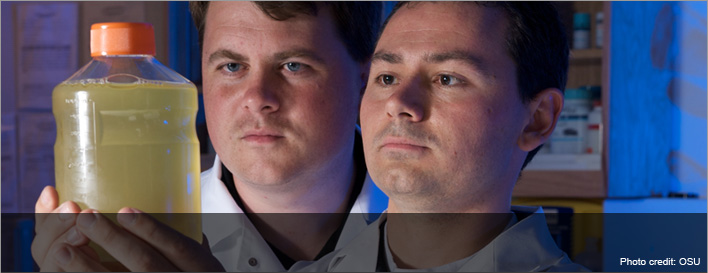
Past RII 2005-2009
Continuing its long-term strategy, which builds upon the state’s existing strengths, Oklahoma EPSCoR is investing in the emerging fields of plant virus biodiversity & ecology and nanoscale science & engineering to bring them both to nationally competitive levels. Both fields involve cutting-edge research and have been identified as federal and state priorities. Funded by NSF EPSCoR, the two multidisciplinary, multi-campus research groups have been formed by investigators at Oklahoma State University (OSU), the University of Oklahoma at Norman (OU), the OU Health Sciences Center (HSC), The University of Tulsa (TU) and the nonprofit Samuel Roberts Noble Foundation (SRNF) in partnership with the private sector.
Plant Virus Biodiversity & Ecology: Viruses are associated with almost every known organism, from eubacteria to archaebacteria to eukaryotes. They are as diverse as the hosts with which they are associated. Yet, we have discovered only a small fraction of this diversity. The biodiversity and abundance of viruses suggests an important role for viruses in our ecosystems. To explore this role, we will uncover information beyond the mere discovery and cataloging of viral sequences. We will discover the diversity and identity of viruses in natural ecosystems concentrating on the Nature Conservancy’s 39,000-acre Tallgrass Prairie Preserve located in northeastern Oklahoma. We will explore virus-host associations, their geographic distributions, how these change with time, and the principles that govern these associations and distributions. A thorough understanding of virus biodiversity in an ecological context will allow profound advances in our understanding of the ecology of both viruses and higher organisms. Viruses of plants and their associated microbes, the endophytes, are ideal for such exploration. Plant virus biodiversity and ecology of natural systems has its central hypothesis: The distributions and evolutionary patterns of viruses are determined by complex environmental interactions among many factors including distributions of hosts, vectors, other viruses and climatic variation.
Nanoscale Science & Engineering: Oklahoma EPSCoR has made substantial investments in research infrastructure in nanotechnology via the Oklahoma Network for Nanostructured Materials (NanoNet) and now via the Nanoscale Materials Research group. The NanoNet is a statewide group of 60 science and engineering faculty, their students, and industrial researchers. Many researchers are working on collaborative projects that cross disciplines, universities, and academe and the private sector. Substantial improvements are being made in instrumentation for characterization of nanoscale materials and in the support staff to make the instruments useful to researchers statewide. The major emphases of the Oklahoma EPSCoR program in Nanoscale Materials Research are in the following areas: 1) Carbon Nanotubes; 2) Fuel Cell Materials; 3) Novel Nanoscale Devices; and 4) Interfaces of Nano and Bio Materials. Oklahoma programs in nanoscale materials are not limited to these four areas. The scientific environment profits from research symposia and courses presented at Oklahoma State University (OSU), University of Oklahoma (OU) and The University of Tulsa (TU) in chemistry, physics, and engineering.
Education & Human Resources Outreach programs have been developed to build the Oklahoma’s human resources in the areas of science, technology, engineering, and mathematics (STEM) through a robust and diverse set of initiatives. Utilizing a multi-spoke approach, EPSCoR has identified five target areas to strengthen participation in the STEM fields:
- Student Development
- K-12 Outreach
- Faculty Development
- Public Outreach
- New Projects
All EPSCoR initiatives are designed to support Oklahoma’s research efforts while encouraging the participation of women, Native Americans and other underrepresented groups. EPSCoR is also making contributions to the educational and human infrastructure that will provide a continuing stream of well-prepared students to the State’s universities and highly qualified college graduates for the state's emerging high technology businesses.
